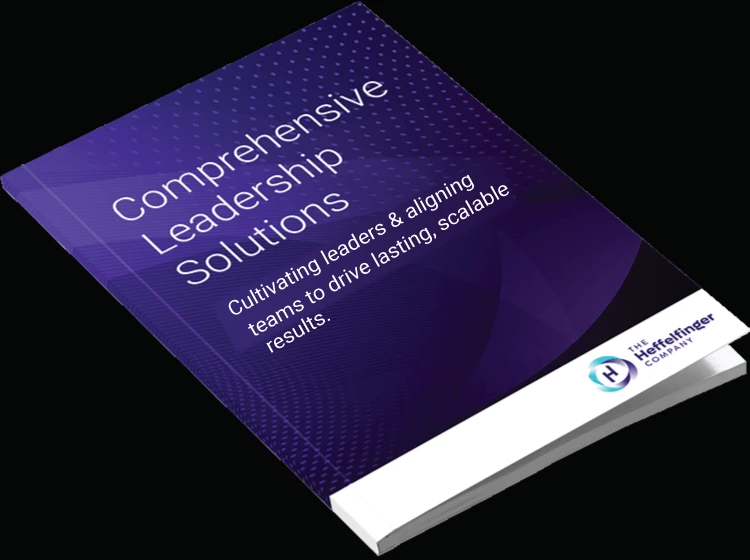The ever-evolving business landscape demands that businesses remain agile in the way they manage change, which depends entirely on the adaptability and skills of its people. Organizations that focus on learning and development (L&D) gain a competitive advantage as they keep top talent engaged and develop a resilient, high-performing workforce. Yet, many organizations struggle to strategize investment in leadership growth as they retain focus on short-term gains. A recent LinkedIn Learning survey uncovered that half of learning and talent development professionals see a skills crisis, with 49% agreeing “My executives are concerned that employees do not have the right skills to execute our business strategy.”
At Heffelfinger Co., we have seen that when businesses implement leadership development strategies through learning & development programs, they become better positioned to manage uncertainty while achieving sustainable growth.
The Business Case for Leadership Development
Strong leadership is about so much more than just making decisions. The quality of leadership directly impacts company performance, culture, and employee engagement. According to the LinkedIn Workplace Learning Report, 83% of organizations say leadership development is crucial, while only 43% feel they’re effective at it. Companies that prioritize leadership growth see measurable benefits, including:
- Higher employee retention. Employees are more likely to stay with a company that invests in their leaders.
- Increased innovation. Strong leaders create environments where employees feel empowered to share ideas and take calculated risks.
- Improved business outcomes. Organizations with effective leadership development programs outperform their competitors in revenue growth and market share.
- Better succession planning. Investing in leadership growth ensures a pipeline of capable leaders ready to step up when they are needed.
The Key to Effective Leadership Development
The key to building an effective leadership development strategy is for companies to focus on continuous learning rather than one-time training sessions. The existing process of "once and done" L&D training isn't sufficient for today's employees and managers; learning should be viewed as a continuous process. Ninety-one percent of L&D pros agree continuous learning is more important than ever for career success. To benefit from their investment, businesses need more manager development in the form of "just in time" or in the flow of work learning. By providing ongoing learning opportunities, such as leadership workshops, e-learning courses, and peer learning groups, organizations encourage leaders to embrace a growth mindset that supports their ability to respond effectively to market changes.
L&D For Coaching and Career Development
In addition to accelerating the flow of the critical skills required to keep pace with business needs, L&D also has a role in improving retention. One of the most effective ways to retain employees and develop leaders is through coaching and learning programs that prioritize career development. This is because upskilling and internal promotions help people feel valued, engaged, and more likely to stay with the organization. According to global HR industry analyst, Josh Bersin, employees expect their employer to help them keep up with current skills, and they will find a job elsewhere if their employer doesn’t make the investment. When talented employees leave, business strategy suffers.
The Role of Leaders in Employee Development
While leadership growth is beneficial for individual advancement, it can also be used to help lift others. Effective leaders create environments where employees feel valued and supported in their own career growth.
It is up to organizations to empower managers to support their employees by providing training opportunities and easy-to-use resources. When businesses empower managers to support employee careers, they become career development champions. As champions, managers guide employees to skill-building opportunities and experiences that will set them up to succeed. These managers also share their employees’ accomplishments and create opportunities for employees to connect with people who can help advance their careers. Unfortunately, only 15% of employees reported that their manager helped them build a career plan in the past six months, which represents a decline of five percentage points from 2024.
Companies benefit when they train leaders to:
- Set a great example by leading with transparency and authenticity
- Inspire others to work toward shared goals
- Foster a culture of learning and innovation
- Empower their team to act
- Provide regular and effective feedback
- Recognize and celebrate employee work
- Recognize and develop high-potential employees
Leaders can develop these skills by learning about the Five Practices of Leadership.
Measuring the ROI of Leadership Development
As learning and development professionals, we know that career development learning drives critical business KPIs, with employee engagement and retention being the most common ways to measure the business impact. However, L&D professionals are now being tasked with proving true ROI and impact to the bottom line. Eighty-nine percent of L&D professionals say it’s a priority to proactively prove the impact of learning programs [Source: 2023 LinkedIn Workplace Learning Report]. Without demonstrating ROI or impact, leadership development professionals will not receive the investment/training dollars so desperately needed for employees and managers to succeed.
Employee engagement and retention have traditionally been the most common ways to measure the impact of career development investments, but 70% of business leaders expect L&D to contribute to business outcomes, not just skill development [Source: 2023 Deloitte Human Capital Trends Report]. Companies should define and gather metrics that demonstrate how the investments they are making in career development and skill-building support the organization’s highest objectives. In many cases, those objectives will be productivity and profits, and reduced turnover costs (88% of organizations are concerned about employee retention and say that learning opportunities are their number one retention strategy).
To prove that L&D has a positive return, companies can measure ROI through quantitative metrics for revenue growth, business agility, reduced turnover costs/better retention rates, and improved performance/productivity, alongside qualitative measures of employee morale and culture.
Build a Culture of Excellence Through Learning & Development
Organizations that prioritize leadership development in 2025 will find themselves better prepared to handle challenges, drive innovation, and retain their best employees. Developing leadership skills should do much more than fill executive positions; its broader purpose is to build a culture of excellence and resilience at all levels that drives productivity and profits. Through investment in ongoing learning, organizations produce leaders who inspire teams and achieve sustainable success.
At Heffelfinger Co., we use EVERYTHING DISC® SOLUTIONS to help you understand yourself AND other people. Everything DiSC® Worksmart is coming soon, which will equip managers with practical skills that they can apply immediately to their teams through five short, facilitated learning modules.
50% Off Limited Time Offer May 5, 2025-July 31, 2025
Be the first to experience Everything DiSC® Worksmart with immediate access to two topics on Catalyst™ and full access to five topics by July 31, 2025.
- Giving Constructive Feedback (available May 5, 2025)
- Managing Conflict (available May 5, 2025)
- Empowering Your Team
- Helping Your Team Navigate Change
- Motivating Your Team
Contact us today to get started!







